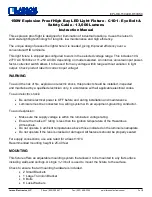
5.1 Transport and installation
The machine will be delivered in a
closed crate.
For transport use a forklift or hand
trolley. Make sure the machine does not
tip or fall off during transport.
The machine is designed to operate in
closed rooms and must be bolted to the
cabinet stand or a solid work bench.
For packing reasons the machine is not
completely assembled.
5.2 Assembly
If you notice transport damage while
unpacking, notify your supplier
immediately. Do not operate the
machine!
Dispose of the packing in an
environmentally friendly manner.
Clean all rust protected surfaces with
petroleum, diesel oil or a mild solvent.
Screw rubber handles onto quill down
feed handle rods (A, Fig 1). Screw
handle rods into hub and tighten.
Slide handwheels (B) onto table
handwheel shafts and tighten set
screws.
Install handle (C)
Mounting machine to stand or solid
workbench.
Unbolt the machine from the shipping
crate bottom.
Caution:
The machine is heavy.
JMDT-804516-DRO= 480 kg!
Assure the sufficient load capacity
and proper condition of your lifting
devices.
Never step underneath suspended
loads.
Carefully place the machine onto the
cabinet stand or a solid work bench.
Use a machinist’s precision level to
make sure that the machine table is
level.
Loosen mounting bolts, shim and
tighten mounting bolts if needed.
The machine must be level to be
accurate.
5.3 Mains connection
Mains connection and any extension
cords used must comply with applicable
regulations.
The mains voltage must comply with the
information on the machine licence
plate.
The mains connection must have a
6-10A Circuit breaker.
Only use power cords
marked H05VV-F
Connections and repairs to the electrical
equipment may only be carried out by
qualified electricians.
Connection takes place on the
appropriate terminal in the electrical
cabinet on the left side of the machine.
5.4 Initial lubrication
The machine must be serviced at all
lubrication points before it is placed into
service!
Failure to comply may cause serious
damage.
(see chapter 8 for lubrication)
5.5 Starting operation
Before starting the machine check the
proper chucking (see chapter 6.2)
You can start the machine with the
green ON-button (K, Fig 4).
The red button on the control box stops
the machine (M).
The emergency stop button (L) stops all
machine functions.
Attention:
The machine still has electric power.
Turn emergency stop button clockwise
to reset.
The Forward/Reverse buttons (P/Q)
may only be operated when motor
power has been stopped before.
WARNING:
Do not change the spindle running
direction while machine is running.
Improper operation may damage the
Fw/Rev switch and gears.
6. Machine operation
Warning:
Setup work may only be carried out
after the machine is protected
against accidental starting.
With pressed emergency stop button.
Never place your fingers in a position
where they could contact any rotating
tool, chuck or cutting chips.
Remove cutting chips with the aid of an
appropriate chip hook when the
machine is at a standstill only.
Never stop the rotating chuck or tool
with your hands.
Always close the chuck guard and
pulley cover before you start the
machine.
Secure workpiece to the table with
clamps or a vice to prevent rotating with
the drill bit.
When using a vice, always fasten it to
the table.
Check the save clamping of the
workpiece, chuck and tools before
starting the machine.
Never do any works “freehand” (hand-
holding the work piece rather than
supporting it on the table).
Support long workpieces with helping
roller stands.
Always adjust the depth stop to prevent
drilling into the table or into the
worholding device.
Feed a drill bit into the material with only
enough force to allow the drill bit to
work. Feeding too slowly may cause
burning of the workpiece or tool.
Feeding too quickly may cause the
motor to stop and/or the drill bit to
break.
Do not use wire wheels or grinding
wheels on this machine.
Fig 1



































